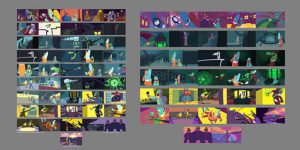
As an Associate Professor and Chair of Animation at the Columbus College of Art and Design (CCAD), our Animation Department has supported numerous cohorts of students as they create their animated films. In the last four to five years, I have noticed the students suffering a chronic reliance on local color. Films contained gorgeous motion, beautiful stories, but the color application was not supporting the narratives.
Using Color Theory for Film
CCAD has a long history of delivering color theory though the Munsell Color System. In the current curriculum, there are several touch-points where students investigate their application of color through Munsell. This is why it was surprising to me to see students thinking about their film’s color-voice as local, anatomical choices. Local Color was reducing the impact of our students’ stories.
Creating Color Symbolism Palettes
To address this, I began a Color Scripts course. This course reinforces CCAD students’ Munsell knowledge and begins a dialogue on color relationships in support of the students’ stories. A Color Script for Animation is a quick, working document that establishes which color combinations relate to specific emotional touch-points of the story. Animators establish relationships that they maintain (or break) based on what they want to communicate to the audience. This Color Symbolism is subtle but highly impactful. It touches the subconscious of the audience—they may not be able to tell how it was made, but they can tell you how it made them feel.

Allie Vanaman, “Sharklock Foams” Beginning vs. End of Semester, Color Scripts 2017
To achieve this, animators can use Color Symbolism. At the most basic level, a story has three Color Symbolism points. For example: Conflict, Peace, and the Transition between those two words. This means that the animator will create color symbolism palettes, one for Peace, which is different than Conflict, which is different than the Transition between Peace & Conflict.

Riley Wagner, Color Symbolism, Color Scripts 2017
Color Symbolism is not a linear application. It is the application of the specific palettes in relation to moments in the film. If the animator maintains these relationships, then the audience will subconsciously connect the palettes with the emotion. The audience will feel a deeper connection to the story.
The beauty of the Munsell System is it labels each instance of color. As students prepare their symbolism, they can produce numeric guides that they can use to judge the success of their film. For example, if a test audience says a scene is confusing, the animator can analyze the scene based on: 1. The Munsell selection of colors, and 2. The Intended Word paired to those numeric colors. This pairing can be objectively analyzed to see if the system remains consistent. If not, the animator will know what they need to adjust in order to bring the color concept back in support of the story.

Alex Falcone, Migration, Color Scripts 2017
The ability of the animator to visually key their stories through the application of a numeric color-system strengthens the visual impact of the story. Stories that pair key emotional touch points with a delineated color palette, and maintain those relationships, will invoke the strongest connection between the film and the viewer. The Munsell System will continue to provide a vocabulary for the students of the Columbus College of Art & Design to develop their animated stories.
About the Author
 Charlotte Belland, Chair & Associate Professor of Animation at the Columbus College of Art & Design, is notorious for her artistic study of animals. Through analogue ink drawings, digital sculpture, and augmented reality, Charlotte adapts a wide range of mediums in the exploration of animal forms. Her favorite drawing medium is ink because it keeps her focused in the present and committed to the line. She has an M.F.A. in Computer Animation from The Ohio State University. You can check out her work on Instagram.
Charlotte Belland, Chair & Associate Professor of Animation at the Columbus College of Art & Design, is notorious for her artistic study of animals. Through analogue ink drawings, digital sculpture, and augmented reality, Charlotte adapts a wide range of mediums in the exploration of animal forms. Her favorite drawing medium is ink because it keeps her focused in the present and committed to the line. She has an M.F.A. in Computer Animation from The Ohio State University. You can check out her work on Instagram.



Leave a Reply